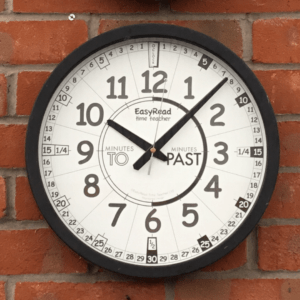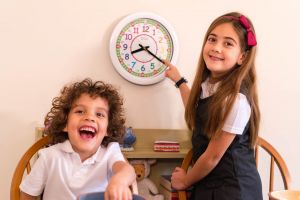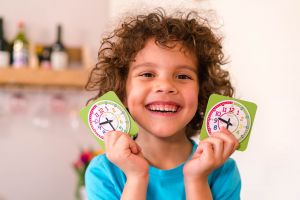
If your syllabus for the new year includes teaching your pupils to tell time, or you are keen to hone their new skills in 2024, then make sure that your classroom is equipped with our classroom clocks and teaching resources. Designed with functionality and accessibility in mind, our clocks are the perfect tool for teaching young children how to apply their new skills and knowledge. Featuring clear, easy-to-read designs and robust structures to withstand the wear and tear of a busy classroom, these clocks are specifically designed as a visual aid to help pupils grasp the concept of telling time, so make time teaching a group effort this new year with our essential teaching clocks.
The importance of the right classroom clock
The right clock for a classroom plays a vital role in teaching children how to read the time and in creating a learning environment. They serve as a visual aid that helps pupils understand the concepts of minutes, hours, and seconds, as well as the relationship between these three and how this creates the passage of time. By having a teach the time clock prominently displayed in a classroom, pupils are able to practise reading and interpreting time in a real-life context, as well as develop core life skills.
Classroom clocks promote time management skills. By having a clock displayed prominently in the classroom, pupils develop a sense of time awareness, and learn how to allocate and manage their time effectively whilst completing a task, meeting deadlines, or remaining punctual to lessons. Clocks also help to create a structured learning environment, as teachers can use them to establish a clear routine that pupils are expected to understand and follow. This includes clearly showing the time left for a specific task or lesson, helping to keep the class on track and minimise disruptions, as well as reduce the number of questions around the time or how long is left in a lesson.
By having an easy-to-read clock prominently displayed, pupils are able to practise reading and interpreting time in a real-life context, so read on to explore the unrivalled benefits offered by our specialist range of clocks.
EasyRead Classroom Clock
Our EasyRead Clocks are designed specifically for classrooms, as their clear, large design makes them visible from all areas of the classroom and ensures that all pupils, regardless of their seating position, can easily access the time.
The simple and engaging design of our clocks is perfect for nursery and primary school classrooms, as well as those who are just starting to learn about the time, as a hands-on teaching aid that introduces the concept of time. Depending upon the preferred method of your school or pupils, your clock can show either the “12/24 Hour” method or the “Past & To” method, as each design has been specially made to make it easy for children to learn to read the time. This simple teaching system contains all the relevant scaffolding that a child needs to confidently recognise numbers, identify the hour and minute hands, and piece together the method to reveal the correct time, and is a great way to start your class on the time-telling elements of the school curriculum. To help with this, the curriculum notes are printed on the back, providing you with a handy reference while teaching, and the hanger makes it easy to securely rehang the clock after a demonstration.
Our specially designed school clocks are made to save time and reduce frustration for pupils and teachers alike, as well as helping pupils build confidence in their own abilities. By hanging one of our specialist clocks in your classroom, you can eliminate the need for pupils to constantly ask you to tell them the time. So, with our clocks, you and your colleagues can focus on teaching, knowing that you have a reliable and effective tool to support your teaching and reinforce your lessons on time.
EasyRead Playground Clocks

The design of these clocks is the same as the rest of our range, including the option to choose either the “Past & To” or “12/24 Hour” method, depending upon the time format taught by your schools’ curriculum. This standardised design allows for a continuation of the pupils’ learning across indoor and outdoor spaces, reinforcing what they have learnt and offering them the ability to read the time themselves, no matter where they are.
With their battery-operated mechanism and robust designs, our playground clocks are built to withstand the elements throughout the school year. The weatherproof powder-coated steel frame and toughened glass lens protects the face from any potential damage, and means that these clocks will continue to function come rain or shine, providing a reliable and accurate time display for your pupils. So, whether these weather-proof clocks are installed in the playground, entrance ways, school garden, or onsite sports facilities, teachers and pupils alike can incorporate time-telling challenges into various outdoor activities, so add one of our clocks to your outdoor space and watch as learning and fun blend seamlessly together.
Other teaching tools and educational activities
To further enhance student learning, our range can be easily combined with our range of educational resources for a streamlined, standardised approach, and additional learning opportunities for pupils. Here at EasyRead Time Teacher, we offer a range of resources that complement the methods used by our clocks, including:
⦁ Tell the Time Cards: These cards are designed to work in conjunction with a school clock to enhance the learning experience and allow pupils to practise telling time through engaging games. These cards feature 15 different times of the day, and pupils of all ages can use these educational resources to play a range of games, including snap, matching pairs, buddy-up, and bingo, to practise their new skills and reinforce their understanding of time in a fun and engaging way.
⦁ TwinTime Cards: The twintime cards are a particularly useful interactive learning resource, as they allow pupils to compare and contrast different times, further developing their understanding of the passage of time. They are a hands-on learning tool that have been specifically designed for primary school children to work through time-related activities and challenges, by adjusting the moveable hands to visualise the relationship between the big and small hands.
⦁ EasyRead Classroom Set: For teachers who want a comprehensive set of teaching resources, the EasyRead Classroom Set is the perfect choice. This set includes an EasyRead clock, tell the time cards, and twintime cards, equipping your classroom with everything you need to create a dynamic and interactive learning environment.
By integrating our clocks with these additional teaching resources, visual aids, and interactive activities, teachers across the country can prepare their classrooms for a year of hands-on learning and ensure that their pupils have access to the resources they need to reinforce their understanding of time.
Enhancing student learning with the right classroom clock from EasyRead Time Teacher
Teaching pupils to read the time is an essential skill, and our classroom resources and clocks are on-hand to support your pupils and maximise their learning. These resources are designed with accessibility and functionality in mind, featuring clear, easy-to-read designs and robust structures that can withstand the demands of a busy classroom, so be sure to promote a multi-faceted approach to learning in 2024 and give your pupils the opportunity to reinforce their learning with our full range of classroom clocks and teaching resources.

Are you struggling to support and encourage your child who can’t tell time? From the ages of 6 and 7, your child will be taught this life skill in schools, but if your little one is struggling or falling behind, then don’t worry – whilst this is likely a source of worry for your family, teaching children to independently read the time is often a challenging task and will probably require the use of additional resources and extra support. That’s why, at EasyRead Time Teacher, we are dedicated to making learning how to tell the time an accessible and engaging experience for any child or adult who can’t tell time. From engaging aids, to our EasyRead clocks, our resources and interactive tools make learning a fun and engaging experience and support parents and children alike to become confident in telling time.
The struggle of telling time
Learning how to read and understand the time is a crucial skill for any young child’s development. Not only is it important for their syllabus and academic development, but it also helps them understand the concept of the passing of time, manage their daily routines, and develop a sense of responsibility. However, some children may find it challenging to grasp this concept, leading to frustration, a sense of falling behind their peers, and concerns around their own capabilities. If your child can’t tell time or is struggling, then it’s important to identify the signs early on and understand the common reasons behind their difficulties.
The most obvious sign that your child is struggling with telling the time is their inability to read analogue clocks or understand the relationship between the hour and minute hands. For young children, many of the challenges come from low level confusion that arises in the moment, rather than a deep-rooted confusion around the passage of time and the overwhelming responsibility of learning to track this passage. However, if your child’s confusion comes from being unable to understand the relationship between numbers and time, or struggling with concepts like half past, quarter past, and quarter to, then their learning will greatly benefit from the inclusion of resources, games, or real-life examples into their daily routine. Additionally, if your child is consistently late or struggles to manage their personal time effectively, it could be an indication that they need additional support to develop their understanding of time.
Supportive strategies to help your child
If your child is having trouble developing this life skill, don’t worry – these difficulties are much more common than many parents realise, and there are several strategies you can employ to support their learning and help them become confident in this essential skill:
1. Use visual aids and resources: Visual aids, such as our EasyRead clocks, provide a tangible representation of time and make it easier for children to understand the relationship between the hour and minute hands. Our clocks and resources feature colour-coded circles for the different hands and clear labels for the 12/24 hour and past and to methods, making it easier for children to break down the overwhelming concept of time into smaller, actionable steps that make it easier to interpret the time.
2. Create a daily routine: Establishing a consistent daily routine is a quick and accessible way to help children develop their understanding of time progression and how it relates to their daily activities. Set regular times for meals, bedtime, and activities, and involve your child in following the schedule by encouraging them to remind you of the time, or by regularly asking them what time they perform a specific task and how much time they have left before then.
3. Break it down: Time is an overwhelming concept for small children, especially when faced with analogue clocks and complex concepts. In order to break down the learning process into smaller, manageable steps, start by teaching them to identify the hours, then move on to the half-hour, quarter-hour, and so on, backed up by consistently asking them to practise telling you the time. Gradually introduce more complex concepts as they become comfortable with the basics, including switching to the 12/24 hour method or introducing a digital clock.
4. Make it fun: Learning should be an enjoyable experience for children, particularly when learning an important skill that they will need to use for the rest of their lives. Incorporating games, activities, and resources into their time-telling practice will help your child come to see time as a puzzle to be solved, or an engaging activity, rather than a complex or overwhelming task, and will develop a positive relationship with managing their own time.
By employing these supportive strategies, you can help your child overcome their difficulties and develop a solid foundation in reading and understanding time. If you’re interested in exploring key educational resources to boost their understanding and practise reading the time, explore our recommendations below.
⦁ Using clocks for teaching and practising

Analogue and EasyRead clocks are invaluable tools when teaching children to understand and practise their time telling abilities. They provide a clear and easy-to-read display of the time, down to the minute, making it simpler for children to identify the current time quickly and with minimal confusion. Introducing clocks throughout your home creates a learning environment in which your child is constantly exposed to time-telling opportunities, without becoming overwhelmed by these new concepts, so here are some of our key recommendations.
- EasyRead Wall Clock: Hang this wall clock in your child’s bedroom or in their play area for the ideal introduction to reading the time. With their clear, easy-to-read designs and silent operation, our colourful clocks use either the past & to or 12/24 hour teaching methods and are perfect for the whole family to use to support your little ones’ time-telling skills.
- EasyRead Alarm Clock: Our alarm clocks feature a large, clear display with a simple design, silent sweeping movements, and an LED nightlight for a discreet and useful addition to your child’s bedside. They’re perfect for teaching children the basics of time-telling and means that they are able to read their clock if they wake up in the middle of the night, or if they wake up before it is time to get out of bed. They also feature a crescendo alarm and a built-in light sensor that matches the brightness of the room according to your child’s preferences.
- EasyRead Wrist Watch: A wristwatch is a portable and practical way for your child to practise reading the time on their own terms throughout the day. With their clear, colour-coded dials and simple teaching method, our watches make it easy for children to practise their time-telling abilities wherever they go, making it the ideal first watch for children aged 4 and above.
By incorporating our clocks into your home decor and your child’s daily routine, you can create a supportive environment for your child to practise and reinforce their time-telling skills.
⦁ Using games to practise and reinforce time-telling skills

Learning to read a clock doesn’t have to be a tedious task, particularly if your child is struggling more than their peers or is becoming overwhelmed by having to practise a skill that they don’t yet fully understand. To combat this, there are numerous fun activities and games you can incorporate into your child’s learning that will not only engage them, but also provide opportunities for them to practise and reinforce their time-telling capabilities whilst playing with friends or family.
If this sounds like the best course of action for you to take with your child who can’t tell time, then here is a rundown of our recommended activities and games from our range:
- Tell the Time Cards: Our cards feature engaging, interactive designs that support children to practise reading and interpreting the time at home. Our easy-to-use cards feature different times of the day and can be played in various ways, such as snap, matching pairs, buddy-up, and bingo, and are designed to cater to the abilities and needs of different age groups, ensuring that children of all ages can engage and learn at their own pace.
- TwinTime Cards: Our TwinTime Cards offer a unique and hands-on approach to interactive time telling practice. With a Past & To dial on one side and a 24-hour time dial on the other, our double-sided cards allow children to independently move the hands to display different times, and then quiz family members or friends on the displayed time. This game enhances children’s understanding of both methods of reading a clock and encourages critical thinking, but also supports other skills like counting forwards and backwards, learning fractions, and counting in 5s and 10s.
By incorporating these activities and games into your child’s learning routine, you can make the time-telling process an enjoyable and interactive experience.
⦁ Collaborative learning

Working with your child’s teacher to support their learning and develop a coordinated approach to practising is a proactive way to ensure your child has all the support and resources that they need. Teachers have access to various resources and strategies that can complement your efforts at home, including playground clocks and classroom sets, so, take the time to discuss your child’s struggles with their teacher and work together to identify the best strategies and resources to support their learning. This collaboration between home and school will provide your child with a well-rounded and consistent approach to learning this important life skill, giving them the best possible opportunity to overcome their struggles.
Celebrating your child’s progress with EasyRead Time Teacher
Teaching and supporting your child may present challenges, but with patience, support, and the right resources, they can develop this essential skill. If your child currently can’t tell time, then be sure to celebrate their progress, no matter how small, and continue to utilise our range of resources and aids to make the learning process engaging and enjoyable for both you and your child.
Explore our full range today, and equip your child with the resources and confidence they need to develop valuable time-management skills that will benefit them throughout their lives.





